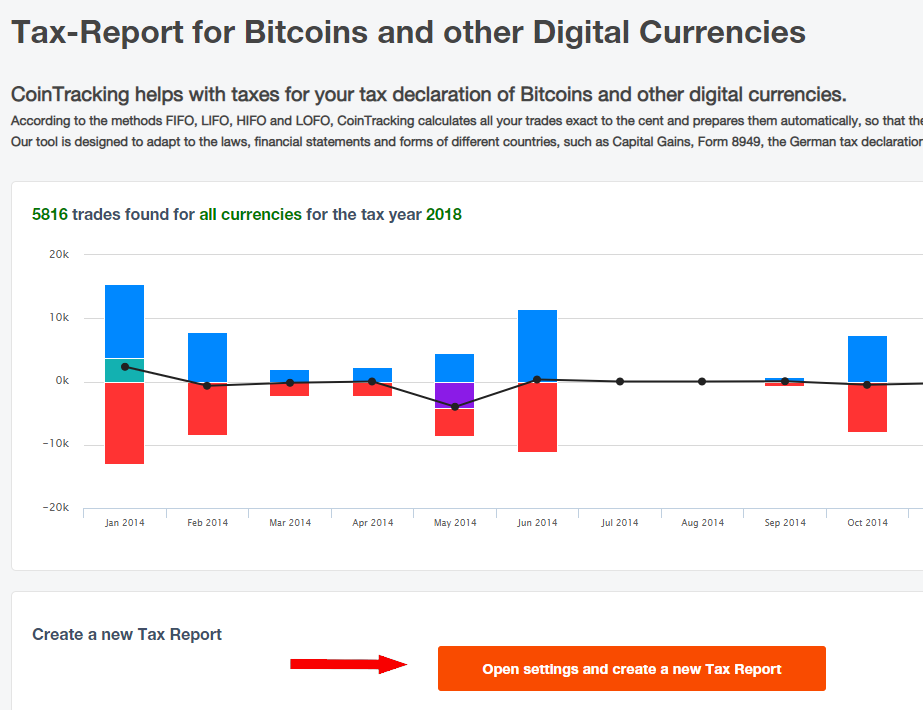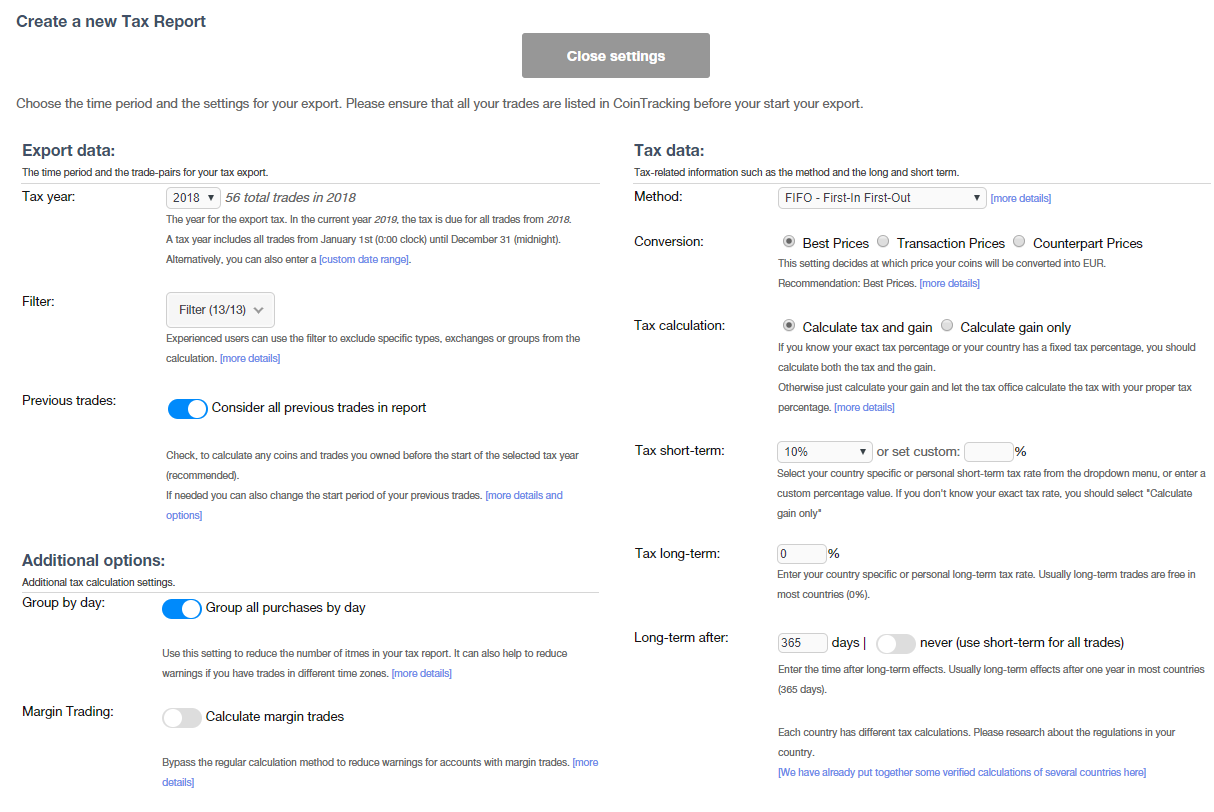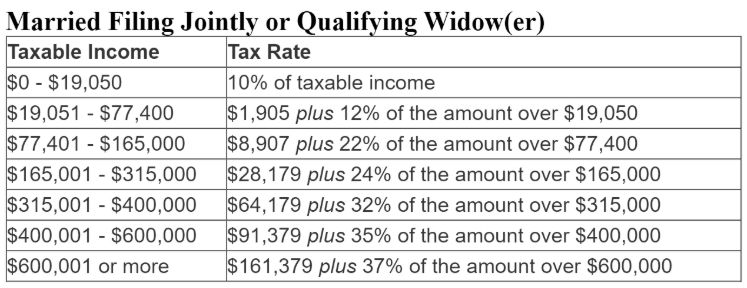CoinTracking.info - the most popular crypto tax calculator
With over 300,000 users, CoinTracking.info is one of the oldest and most trusted cryptocurrency tax calculators on the market today. The original software debuted in 2014. Since then, its developers have been creating native apps for mobile devices and other upgrades.
Real-time reports, profit/loss analysis and automatic data import via exchange APIs are just a few of CoinTracking.info’s features.
Check out the live demo
(no signup required) or create an account for free and give CoinTracking.info a test drive.
What is a crypto tax calculator?
Crypto tax calculators - also known as crypto tax estimators - retrieve data from your cryptocurrency wallets and exchanges. They then process this data and determine how much you made or lost during the year. This information is especially useful for finding out how much you can deduct from your taxable income if you lost money trading crypto in the previous year.
Setting up CoinTracking.info is easy. A free account allows you to import your data. Doing so is a simple matter of selecting your cryptocurrency exchange from the list.

For example, let’s say that Coinbase Pro is your main cryptocurrency exchange. To pull in your trading data, just log into your Coinbase Pro account and create an API key. Then, copy your API key and your API key secret into CoinTracking.info. The import pulls all your trades, deposits and withdrawals. The entire process only takes about five minutes.

The Tax Report button on the top right side of the interface takes you directly to the tax report generation page. A graph gives you a high level look at your trades for the year. When you’re ready to do your taxes, you can do so with the click of a button.

The settings menu lets you test out several different accounting methods. Unlike many crypto tax calculators, CoinTracking.info supports margin trading.

After you generate the report, you can import it into TaxACT or TurboTax. Other download options include PDF, CSV and Excel.

If you're a casual cryptocurrency trader, you can use the free version of CoinTracking.info to find out what your tax liabilities look like. Advanced users that placed more than 100 trades should upgrade to CoinTracking Pro, Expert or Unlimited. Paid users receive priority customer support. Click the button below to learn more.
Tax rules for cryptocurrency traders
Once you have your report, you can determine if you qualify for a tax deduction. This can be particularly helpful during years like 2018. Prices plummeted and many people who bought money at the beginning of the year ended up with significant losses by the end of it. Selling cryptocurrency for a loss can allow you to deduct money from your yearly income.
Write off your crypto losses
In the United States and many other countries, you can file a capital loss deduction if you lost money trading cryptocurrency in any given tax year. Capital loss deductions reduce your overall tax obligations by allowing you to move into a lower tax bracket. This can save you money at tax time.
Move into a lower IRS tax bracket
If you’re a US resident, your yearly income places you in one of seven different tax brackets. Dropping down a bracket can result in significant tax savings.

If you’re married and filing jointly or widowed, you may even save more money with capital loss deductions.

Other countries
The tax report that CoinTracking.info gives you all the information you need to do your tax, no matter where you reside. Other countries have similar rules for filing crypto taxes, but differences do exist. For example, Australia’s ATO (Australian Tax Office), the UK’s HMRC (His Majesty's Revenue and Customs) both use different tax metrics.
The commonality among tax agencies is that most don’t regulate cryptocurrencies in the same way that they regulate government-issued currencies. The majority of governments consider cryptocurrencies to be assets, like gold bars or equities.
Tax authorities in some countries make decisions about the legality of crypto tax write-offs on a case-by-case basis. Be sure to research the rules and regulations around cryptocurrency and taxes before you submit your tax report.
How to find out how much you can deduct
Without the necessary tools, the complicated part of determining how much you can deduct is doing the math. If you keep track of your buy and sell orders manually, you have to first find out what the price of whatever asset you bought was at the time of your initial purchase. Then, you have to find out the difference between that price and the price at the time you sold.
Don’t estimate your crypto taxes - get the exact numbers
CoinTracking.info greatly simplify the process of finding out how much you owe - or how much you can deduct from your income. All you have to do is link your cryptocurrency exchange accounts together and then CoinTracking.info takes care of the rest.
IRS form 8949
After you complete the setup process, you’ll be able to download several different types of tax reports. CoinTracking.info will even generate IRS form 8949 for you. This is the form that you need to include with your return to file a capital loss or capital gain.
Alternatively, you can import your cryptocurrency trading data into TaxACT and/or TurboTax. Other supported report download formats include PDF, CSV and Excel.
Recommended by certified tax professionals
CoinTracking.info is the crypto tax tool of choice among tax professionals. CPAs like it because of its comprehensive set of features, accurate coin tracking and ease of use.

CoinTracking.info works with Coinbase and other top exchanges
In addition to Coinbase, CoinTracking.info is compatible with many other cryptocurrency exchanges. You can import your data directly from Binance, Bitfinex, CEX.IO, Kraken and any of the exchanges listed below. Supported wallets include Electrum, Exodus, Mycelium, Trezor and more.

Support for multiple tax accounting methods
CoinTracking.info supports four different accounting methods: Average Cost, FIFO, LIFO, HIFO and LOFO. Here’s a quick explanation of the differences.
FIFO
FIFO stands for first in, first out. This is one of the most popular accounting methods used by crypto traders and accountants.
Under FIFO, if you bought BTC for $5000 and sold it later in the tax year for $15,000, you would report a $10,000 gain. Though FIFO is a very straightforward method because all the information you need to determine the value of the asset is the price at which you bought it.
LIFO
Some governments let crypto traders use an accounting method called LIFO (last in, first out).
Under LIFO (last in, first out), you would only have to report a gain of $5,000 for the the same transaction described in the FIFO section above. However, many tax agencies - including the IRS in the United States - do not accept LIFO. Research what’s allowed in your country before you submit.
Average Cost
Average cost is another popular accounting method that some crypto traders use to file their tax returns. In this method, the average market price of an asset is used to determine the cost basis (the original value of an asset for tax purposes).
For example, let’s say you bought a 1 cryptocurrency for $5,000 but the average cost of it at the time was $7,500. Then, you sold it in the same year for $15,000. Your cost basis and net gain would both equal $7,500.
HIFO
HIFO stand for highest in, first out. With HIFO, you can account for changes in the value of cryptocurrency over time.
Let’s say that you’re using HIFO and you bought a cryptocoin for $100. Later, you bought again when the price increased to $200. After that, you made another purchase when the price was $400. Then, the price dropped to $300. HIFO would let you take a loss in this situation, but other accounting methods would require you to report an overall gain.
LOFO
LOFO stand for lowest cost, first out. In this method, the tax lot with the lowest unit cost is assumed to be the first sold.
For example, let’s say you purchase 100 cryptocoins for $5, the 100 additional coins for $7 the next month. Several weeks later, you sell 100 coins when the price reached $8. In LOFO, the first purchase would be the one that would be used to calculate cost basis. The result would be a $300 short gain.
Find out what your tax situation looks like with CoinTracking.info
Crunching the numbers yourself with CoinTracking.info will give you some idea of how much you can deduct or how much you owe before you consult a professional tax advisor. Alternatively, if you only made a few cryptocurrency transactions during the last tax year, a subscription to CoinTracking.info may be all you need to file your taxes yourself.